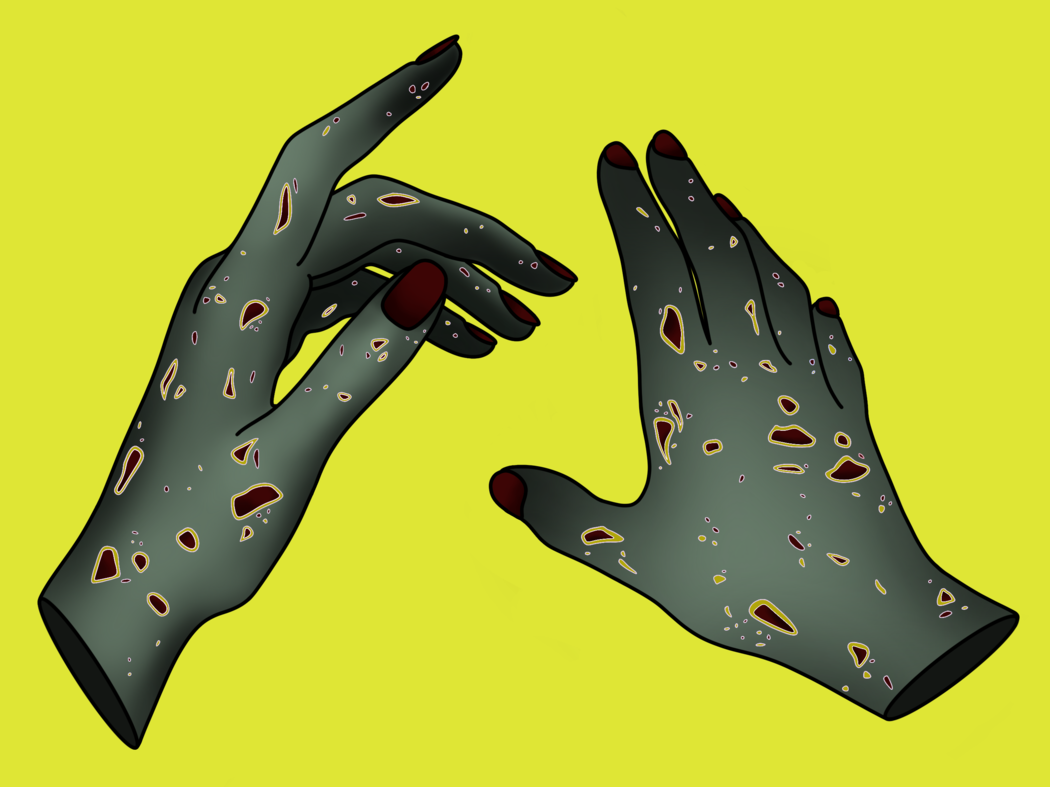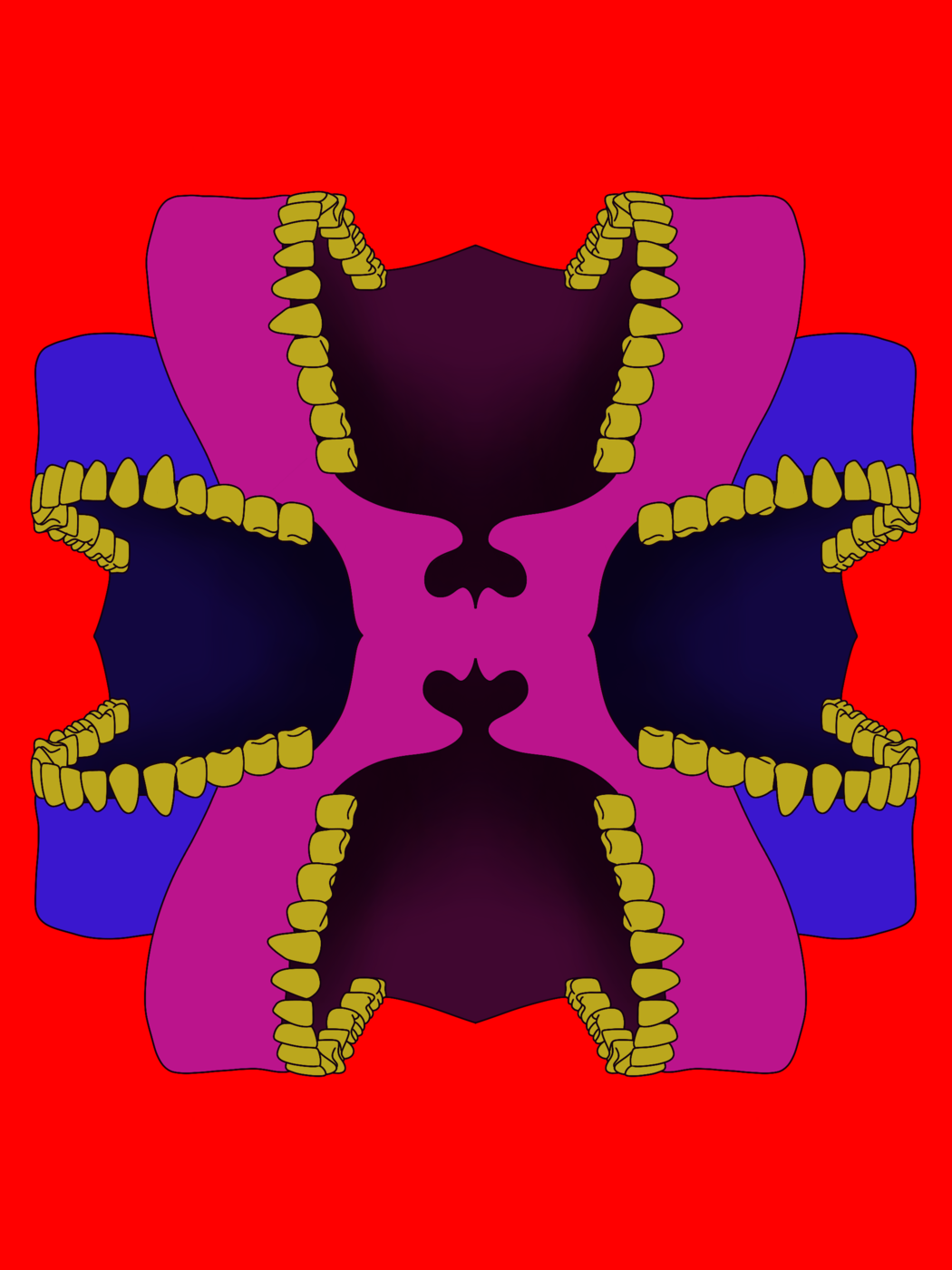Rita Kirsner
Your work explores color as a catalyst for memory and emotion—can you share a specific memory or feeling that influenced one of your recent pieces?
Color plays a pivotal role in my work, serving as both a visual and emotional conduit. For example, the color yellow is often associated with brightness and warmth, reminding us of sunshine and light, yet it also carries darker connotations, symbolizing cowardice and treachery – an association dating back to medieval times. Color has an intrinsic impact and influence on us, from cultural and historical contexts to personal emotions.
My recent piece, Stay Home, depicts a house engulfed in wild, untamed flames in the interior and exterior of the structure. Notably, these red and pink flames are highly saturated to purposefully draw the viewer’s eyes to the flames.
Conversely, the background of the painting and the silhouette of the man in the doorway are both blue – the color of water as opposed to red, the color of fire. Blues are often used to suggest calmness, melancholy, and divinity. Meanwhile, the color of the house and roof have been left neutral and unassuming so as to not detract attention from the focal points.
Upon conception, this piece was meant to represent the human tendency to remain passive in the face of danger, even when we are aware of impending harm. I am guilty of exhibiting willful ignorance towards destructive forces in my life in favor of the mentality ‘ignorance is bliss’. While I knew that I would be burned, I chose to look the other way to avoid dealing with the issue.
My use of color throughout this piece evokes a sense of detached calmness to highlight the dissonance between the urgency of the fire and the man’s indifference to it.
How does your use of digital techniques influence the emotional or sensory impact of your work?
The use of digital techniques is quite new to me, and it was not until 2022 that I began to fall in love with digital art. As I learned through trial and error, I realized how different it was to look at a digital painting compared to a physical painting.
In the digital realm, tools like custom brushes allow me to create a variety of textures. I found value in simplicity – particularly in creating smooth, flat surfaces – no texture as a texture. The visual smoothness I achieve through the use of these techniques allows me to create a silky, buttery quality.
For instance, in Chomps, the polished, smooth textures contrast with the jagged subject matter of human jaw bones. By flattening the texture, potentially distressing subject matter becomes more accessible and comfortable to view. In the 17th century, memento moris (remember you must die) were a common practice. Chomps could be referred to as my contemporary memento mori – a reminder to live a meaningful life.
The inherent digital qualities of symmetry and precision in Chomps enhance the sensory experience.
Our senses are unequivocally connected to our emotions. The way it feels to hug a loved one, the taste of your favorite home cooked meal, the smell of your home after a long day at work. All of these sensory experiences evoke strong emotional responses.
The use of digital techniques open new ways to manipulate and communicate texture, color, and form while engaging the viewer on a deeper, sensory level.
 Rita Kirsner | Stay Home | 2025
Rita Kirsner | Stay Home | 2025
In your opinion, how has the increasing role of technology changed the relationship between artist and viewer?
The increasing role of technology has profoundly reshaped the dynamic between artist and viewer.
In the beginning, art was a way to keep records. We have been making art for thousands of years. Ancient humans left us with cave paintings. Aside from their bones, this was oftentimes the only physical evidence that they ever existed. Art endures, and will outlive us all.
Throughout history, patrons of the arts commissioned artists to paint and record battles, leaders, deities, and to erect statues and architectural wonders of the world. Hiring an artist was the only way to obtain tangible images of loved ones. The public also depended on artists to depict what they were unable to read in books prior to widespread literacy.
In the early 19th century when photography was invented, artists ceased to be the predominant recordkeepers of society.
In 2025, the relationship between artist and viewer continues to evolve. Anyone can go online and access more information and art than has ever been available. We are constantly bombarded with images on our phones, computers, and televisions. This has created a seemingly overwhelming amount of competition – not just from other creators, but from the constant flow of information and AI-generated content.
While this has created difficulties for us, it has also made art more accessible to viewers around the world, allowing for wider distribution and exposure.
I am grateful to be an artist working with the aid of technology. While it would be interesting to have been an artist during the Renaissance, for example, I believe that humanity’s perpetual progress should be celebrated. Ultimately, we are emotional beings, and we will never stop creating art.
The textures in your pieces often suggest tactility—do you consider the physicality of your materials when designing digital works?
In school, a desire of mine was to make paintings that could be physically engaged with. Over time I realized that allowing every viewer to touch a painting would be impractical given my techniques. Eventually I came to understand that suggestion can be just as effective when given the proper visual cues to guide the viewer’s perception.
In my digital work I focus on creating the illusion of texture through deliberate brush choices, color gradients, and variations in line weight. For example, in a piece like Chomps, I pay close attention to how textures are communicated visually, even if the work will never be physically touched.
Owning a physical piece of art is important to some viewers. Luckily, transferring a digital piece to a print is relatively simple. When doing so, I consider how the painting will translate to the medium on which it is printed. A flat digital painting might be best suited for a glossy surface, while a more textured piece could be better suited for canvas.These decisions are crucial to successfully transform a digital piece into something tangible.
Even when confined to a screen, I aim to make the viewer feel as though they could reach out and feel the texture of the painting.
 Rita Kirsner | Hand Holders IV | 2025
Rita Kirsner | Hand Holders IV | 2025
How do you approach abstraction without losing emotional connection with the viewer?
Abstraction has been a recurring theme in my practice. It is an ongoing process of testing boundaries: How much can I take away? How much can I add? How far can I distort the image? What makes sense and what does not? What does the viewer need to take away?
Many of my abstract works have gone through a series of “failures”. These failures are invaluable learning experiences. Over time I have come to understand that abstraction is less about perfecting a formula for success, and more about trusting the process and learning from missteps.
Feedback from fellow artists and casual viewers can also provide valuable information from an outsider’s perspective. Such feedback can be useful in deciding what works and what does not. Throughout my time at SCAD, I was spoiled by constant access to other artists to critique my art. Once that resource was removed, I had to become my own critic.
It is easy to overlook certain aspects of your own art that appear obvious to the viewer. One of the cardinal rules I was taught by my favorite painting professor was to step about ten feet back from my painting at least once every 10-15 minutes to freshen my eyes. Likewise, showing my work to others tends to offer similar benefits.
While my art is the ultimate expression of myself, it still needs to ‘land’. This is especially true when working on commissions.
At its core, art is subjective – I will never be able to please everyone (although that would be nice). Finding the right audience and focusing my practice towards them is a challenge I continue to work on to maintain an emotional connection.
Tell us about the process behind one of the works from this series—what was the initial idea, and how did it evolve?
Hand Holders IV is the fourth installment of my Hand Holdersseries that explores and abstracts the form of human hands. Unlike earlier pieces in the series, there is no mirroring used in this piece, which allowed for a simpler composition.
The goal was to evoke feelings of discomfort in the viewers while maintaining a semblance of visual appeal. Trypophobia, or the fear of holes (often irregularly shaped and clustered together) was kept in mind throughout the creation of this piece.
After sketching out the hands, I colored them in with a sickly, muted green. I wanted to play with dimension, so I gave more depth to the hands by adding highlights and shadows. Upon creating the irregular shapes on the hands, I colored the outlining rings with a flat chartreuse while adding variations to the reds in the middle. The finger nails are not a focal point, so I added minimal shading, less detail, and no white outlines.
The background remained white until the final stages, as I wanted to introduce a contrast that would enhance the hands. I opted for a bright, saturated yellow, which vibrates against the muted tones of the hands. I often leave the background for the very end when working digitally, since I see it as a way of enhancing the main subject matter.
Initially the predominant cause of discomfort was intended to come from the hands themselves, but as the work evolved, I realized that color played a significant role in amplifying that unease.
 Rita Kirsner | Chomps | 2025
Rita Kirsner | Chomps | 2025
Do you see your art as a personal form of therapy or more of a universal emotional experience?
Art functions as a form of preverbal communication for me, often providing insights into my emotions before my conscious mind catches up. It functions therapeutically in the sense that it helps me process my feelings, however it can also be frustrating when things do not go as planned. I have learned to step away from a piece when needed, although I always return.
In its most therapeutic form, art allows me to express myself when words fall short. In fact, art is used as a therapeutic modality by many mental health professionals to help patients process trauma, grief, depression, and more.
Although not every person wants to express themself through art, but everyone does crave an outlet to channel their emotions. This is universal. For some this could mean working out, for others it could mean singing in the shower, and for me – I make art.


Leave a Reply